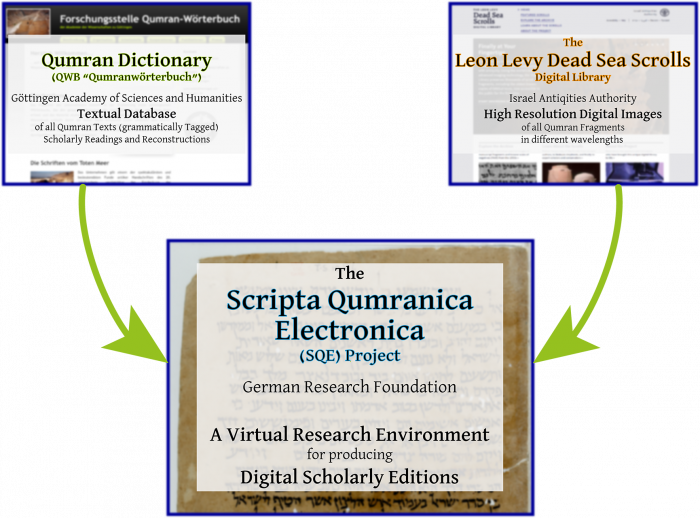to Scripta Qumranica Electronica >>>
The S C R I P T A Q U M R A N I C A E L E C T R O N I C A project (SQE) is all about digitizing the famous Dead Sea Scrolls. First discovered by Bedouins in 1947, the Scrolls are currently curated by the Israel Antiquities Authority (IAA) and the Shrine of the Book at the Israel Museum in Jerusalem. SQE aims to create a new standard online platform for Dead Sea Scrolls editing, and to prepare pioneering Digital Scholarly Editions of Qumran Texts. It is the intention of the SQE project to provide scholars and the public alike free, open access to its tools for Dead Sea Scrolls research. The dynamic, extensible, and collaborative platform will inaugurate the next generation of Dead Sea Scrolls research.
Combining the digital images of all known Qumran fragments at the Leon Levy Dead Sea Scrolls Digital Library, IAA, Jerusalem, with the textual and linguistic data for all texts included in Qumran Digital, the digital Qumran Dictionary at Göttingen Academy, SQE brings together scholars of the Scrolls, scholars of AI, and database specialists, and strives toward broad public outreach. The highly customized and cutting-edge tools will enable students and scholars of this historic corpus to explore it from hitherto inaccessible angles.

Currently, the joint Göttingen/Haifa project consists of two editorial teams (Göttingen Academy and Haifa University) and two IT teams (Göttingen Academy and Tel Aviv University), and several additional partners. The principal investigators are Prof. Dr. Reinhard G. Kratz (Theological Faculty, University of Göttingen) and Prof. Dr. Jonathan Ben-Dov (now at the Department of Bible, Tel Aviv University ), together with Prof. Dr. Nachum Dershowitz (School of Computer Science, Tel Aviv University). Partners include the Israel Antiquities Authority (Pnina Shor, Dr. Joe Uziel), the Department of Hebrew Culture Studies at Tel Aviv University (Prof. Dr. Noam Mizrahi), and the Göttingen Academy of Sciences and Humanities (apl. Prof. Dr. Ingo Kottsieper).
The SQE project is a German-Israeli cooperation financed through the
German-Israeli Project Coordination (DIP) of the ![]() (German Research Foundation), in partnership with:
(German Research Foundation), in partnership with:




